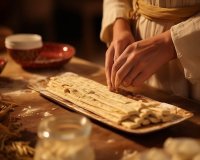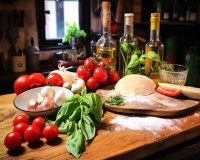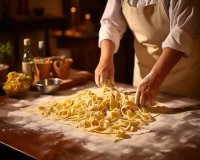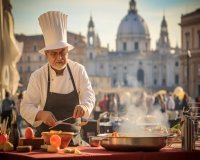The Ultimate Guide to Cooking Authentic Roman Delicacies
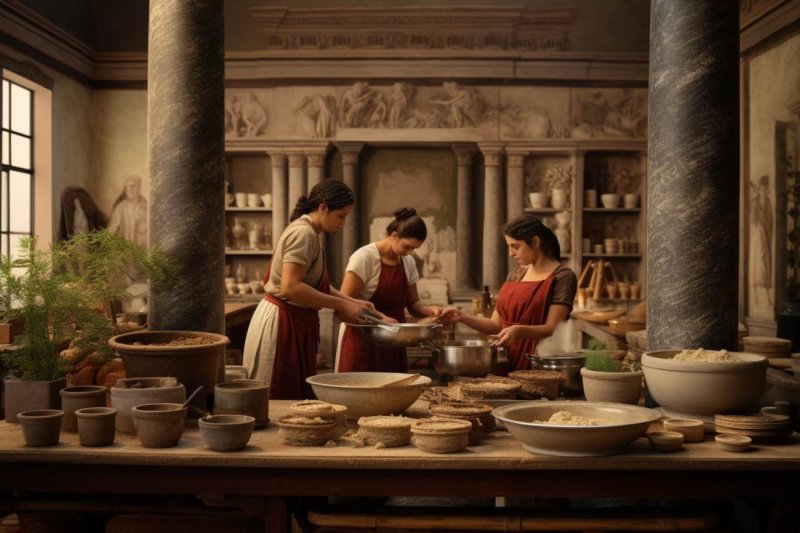
The Ultimate Guide to Cooking Authentic Roman Delicacies
Rome, the Eternal City, is not only known for its rich history, stunning architecture, and vibrant culture but also for its mouthwatering cuisine. When it comes to Roman delicacies, you're in for a treat that will tantalize your taste buds. In this ultimate guide, we'll explore some of the most iconic dishes of Rome and how to prepare them authentically.
Roman Cuisine: A Culinary Journey
Roman cuisine is deeply rooted in tradition and simplicity. It is characterized by the use of fresh, high-quality ingredients and time-honored cooking techniques. Let's delve into some of the must-try dishes that define the essence of Roman gastronomy.
1. Cacio e Pepe
Cacio e Pepe is a classic Roman pasta dish that showcases the beauty of simplicity. It's made with just three ingredients: Pecorino Romano cheese, black pepper, and pasta. To make this delectable dish:
- Boil spaghetti until al dente and reserve some pasta water.
- In a pan, toast freshly ground black pepper until fragrant.
- Add cooked pasta and pasta water to the pan.
- Stir in grated Pecorino Romano cheese until creamy.
- Serve hot, garnished with more cheese and pepper.
2. Carbonara
Carbonara is another pasta masterpiece of Roman cuisine. The key to an authentic Carbonara lies in the creamy sauce created by combining eggs, Pecorino Romano cheese, and guanciale (cured pork cheek). Here's how to prepare it:
- Cook guanciale until crispy.
- Whisk eggs and grated Pecorino Romano cheese together in a bowl.
- Cook spaghetti and combine it with the guanciale.
- Quickly stir in the egg and cheese mixture to create a creamy sauce.
- Season with black pepper and serve immediately.
3. Roman Supplì
Roman Supplì is a popular street food snack and a delightful appetizer. These rice croquettes are filled with gooey mozzarella and deep-fried to perfection. Here's how to make them:
- Cook Arborio rice until tender.
- Let the rice cool and mix it with egg and grated Parmesan cheese.
- Take a small portion of the rice mixture, place a cube of mozzarella in the center, and form a ball.
- Roll the rice ball in breadcrumbs and deep-fry until golden brown.
- Serve hot, and watch the cheese ooze out when you take a bite.
4. Saltimbocca alla Romana
Saltimbocca alla Romana is a classic Roman meat dish that combines veal, prosciutto, and sage. It's a burst of flavors in every bite. To prepare this elegant dish:
- Place a slice of prosciutto and a sage leaf on a veal scallop.
- Secure them with a toothpick.
- Dredge the veal in flour and sauté in butter and white wine until cooked.
- Serve with a delightful pan sauce made from the cooking juices.
5. Roman Artichokes (Carciofi alla Romana)
Roman cuisine is also famous for its artichoke dishes. Carciofi alla Romana is a wonderful way to enjoy this vegetable. To prepare it:
- Trim and clean fresh artichokes, removing tough outer leaves.
- Stuff them with a mixture of garlic, mint, and parsley.
- Place the artichokes in a pan with olive oil and a splash of white wine.
- Cook until tender, and serve with the cooking juices as a flavorful sauce.
Conclusion
Exploring the authentic Roman delicacies is a culinary journey that will transport you to the heart of Italy. These dishes capture the essence of Roman tradition and are sure to leave you craving for more. Whether you're savoring the simplicity of Cacio e Pepe or indulging in the richness of Saltimbocca alla Romana, Roman cuisine is an experience not to be missed. Buon appetito!
Rome: Pasta and Tiramisu Italian Culinary Experience
Explore the richness of Italian culture through a hands-on cooking class that delves into the art of crafting homemade pasta and traditional Roman sauces. Led by experienced chefs, this workshop offers an immersive experience in authentic Italian culinary traditions.
Experience Highlights:
- Learn the art of making authentic pasta from scratch
- Create a delightful tiramisu dessert using fresh local ingredients
- Benefit from the expert guidance of an experienced chef
Full Description:
Embark on a culinary journey starting with the preparation of a delicious tiramisu, showcasing the use of fresh local ingredients. The chef will share fantastic, authentic recipes that you can take home. Following the tiramisu, dive into the world of homemade pasta, where you'll craft your choice of local sauce from scratch. This is a unique opportunity to unlock the secrets of exceptional Italian cooking from a seasoned local chef.
Participating in this engaging course ensures not only an enjoyable experience but also equips you to recreate authentic Italian dishes at home for years to come.
What's Included:
- Pasta and Tiramisu workshop (if selected)
- Spritz and Spaghetti workshop (if selected)
- Fresh hand-made pasta with local ingredients
- 1 glass of wine, 1 glass of prosecco, and unlimited water and soft drinks
- 1 glass of limoncello
- Tiramisu (if selected)
The History of Roman Cuisine: Exploring the Culinary Legacy of Rome
Roman cuisine holds a fascinating place in the annals of culinary history. It is a testament to the rich tapestry of flavors, techniques, and ingredients that evolved over centuries in ancient Rome. This article delves into the diverse elements that shaped the gastronomic culture of the Roman Empire.
Ancient Roman Diet: From Humble Beginnings to Opulent Feasts
The early Roman diet was modest, consisting primarily of staples like grains, legumes, and vegetables. Bread, known as 'panis,' was a fundamental part of every meal. It formed the cornerstone of Roman sustenance, with various types of bread catering to different social strata.
As the empire expanded, so did the diversity of Roman cuisine. The introduction of new ingredients from conquered lands, such as olives, grapes, and spices, revolutionized their culinary repertoire. The Mediterranean climate also played a pivotal role in shaping the flavors of Roman dishes.
The Influence of Class and Status
Roman society was stratified, and this division was reflected in their culinary practices. The wealthy indulged in extravagant banquets known as 'convivia,' where a dazzling array of dishes were served. These feasts showcased the opulence and sophistication of Roman cuisine, featuring exotic meats, seafood, and elaborate desserts.
On the other end of the spectrum, the common folk relied on simpler fare. Porridge, vegetables, and occasional bits of meat constituted the daily sustenance of the working class.
Culinary Techniques: Mastery of Flavors
The Romans were adept at various culinary techniques that are still influential today. They excelled in the art of preserving food through methods like salting, pickling, and drying. The use of garum, a fermented fish sauce, added a distinctive umami flavor to many dishes.
Roasting, boiling, and stewing were common cooking methods. Roman cooks were also skilled in creating delicate pastries and confections, showcasing their prowess in the pastry arts.
The Global Reach of Roman Cuisine
As the Roman Empire expanded, so did its culinary influence. The roads built by the Romans facilitated the exchange of ingredients and culinary traditions across vast territories. This resulted in a fusion of flavors and techniques, leaving an indelible mark on the cuisines of Europe, North Africa, and the Middle East.
Legacy and Continuation
Although the Roman Empire eventually fell, its culinary legacy endured. Elements of Roman cuisine can still be found in modern Mediterranean and European dishes. Staples like pasta, olive oil, and wine continue to be fundamental ingredients in many culinary traditions.
In conclusion, the history of Roman cuisine is a captivating journey through time, revealing the evolution of taste and technique in one of the world's greatest empires. From humble beginnings to extravagant feasts, the culinary legacy of Rome continues to influence and inspire chefs and food enthusiasts around the globe.
Rome: Authentic Italian Cooking Experience
Immerse yourself in the culinary wonders of Rome with our Italian Cooking Class accompanied by a Farmer's Market shopping adventure. This 4.5-hour experience is more than just a cooking class; it's a journey into the heart of Italian gastronomy.
Explore the vibrant Campo de' Fiori market, where you'll handpick fresh, local ingredients under the expert guidance of our English-speaking chef. The market visit is not just a shopping spree; it's a sensory delight with a burst of colors, earthy aromas, and a diverse array of fruits and vegetables.
Upon gathering your ingredients, embark on a short journey to our cooking school, strategically located near Piazza Navona. A warm welcome awaits you with a prosecco and antipasti reception, setting the perfect tone for your culinary adventure.
Under the careful instruction of our experienced English-speaking chef, you'll delve into the art of crafting a traditional 4-course Italian meal. From pasta-making techniques to the final presentation, every step is an opportunity to absorb the essence of Italian cuisine.
Highlights of the experience include:
- Farmers’ Market exploration with an expert chef
- Prosecco and antipasti reception
- Guided cooking session with all necessary ingredients and equipment provided
- Creation of a homemade meal paired with refreshing drinks
Visiting Rome goes beyond its historic landmarks; it's about savoring the culinary heritage. Join us for an unforgettable culinary journey that blends market exploration, hands-on cooking, and the joy of relishing your own Italian feast.
The Secrets Behind Roman Recipes in Ancient Rome
When we think of Roman history, it's often images of grand architecture, conquering armies, and toga-clad senators that come to mind. But behind the scenes, in the heart of ancient Rome, a rich culinary tradition thrived. Roman cuisine was a reflection of the empire's diverse population and access to a wide array of ingredients. In this article, we'll uncover the secrets behind Roman recipes and the culinary delights of ancient Rome.
The Influence of Geography and Culture
Roman cuisine was heavily influenced by the geography of the empire, which spanned across three continents. This vast territory allowed the Romans to access a wide range of ingredients, from the olive oil of the Mediterranean to the exotic spices of the East. This diversity is a key feature of Roman recipes, which often combined ingredients from different regions.
The Romans also incorporated the culinary traditions of the many cultures they conquered. For example, the recipe for "garum," a fermented fish sauce, is believed to have been borrowed from the Greeks. This sauce became a staple in Roman cuisine and was used in a variety of dishes.
The Importance of Apicius
One of the most famous figures in Roman culinary history is Apicius, a Roman gourmet who lived during the 1st century AD. He is often attributed with writing one of the earliest known cookbooks, "De Re Coquinaria" or "On the Subject of Cooking." This ancient text contains a wealth of information about Roman cooking techniques, ingredients, and recipes.
Apicius's cookbook reveals some fascinating insights into Roman gastronomy. Many of the recipes feature lavish and extravagant ingredients such as exotic spices, seafood, and game meats. It's clear that the Roman elite had a penchant for indulgent and opulent dishes.
Popular Roman Dishes
While the upper class enjoyed extravagant feasts, the common people of Rome had their own set of beloved dishes. Some of these have stood the test of time and can still be found in Italian cuisine today. Here are a few examples:
| 1. Garum |
As mentioned earlier, garum was a fermented fish sauce that was used as a condiment in various dishes. It added a salty and umami flavor to Roman cuisine. |
| 2. Puls |
Puls was a basic porridge made from emmer wheat, spelt, or barley. It was a staple food for the common people and was often served with various toppings such as cheese, honey, or vegetables. |
| 3. Moretum |
Moretum was a simple but flavorful spread made from garlic, herbs, cheese, and olive oil. It was often eaten with bread. |
The Legacy of Roman Recipes
The influence of Roman cuisine can still be seen in modern Italian cooking. Elements such as pasta, olive oil, and a preference for fresh, seasonal ingredients have their roots in ancient Rome. The idea of combining diverse ingredients to create harmonious and delicious dishes is a tradition that continues to this day.
So, the next time you enjoy a plate of pasta with a rich tomato sauce or savor the flavors of a classic Italian pizza, you can trace a part of that culinary heritage back to the secrets of Roman recipes. The ancient Romans may have built an empire that shaped the course of history, but they also left behind a delicious culinary legacy that continues to tantalize taste buds around the world.



